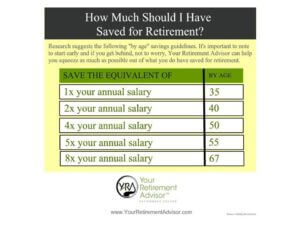It’s Never Too Late to Get in the Game: 8 Strategies to Help You Catch Up on Your Retirement Savings
So here’s where experts say you should be in your savings goal by age.

If this chart has you fidgeting and biting your fingernails, we get it. MANY people are behind in their savings goals (the average American between the ages of 55 and 64 has about $104,000 in retirement savings)[i]. Life has a way of happening… college tuition, vacations and weddings to be paid for. And emergencies happen too. Divorce, job loss and health issues can also greatly impact your savings rate.
But there is good news and no reason to throw in the towel just yet. No, living with one of your kids is not a viable option, just in case that’s what you were thinking.
Let’s assume you’re in your 40s or 50s…you still have a few decades to save and grow your assets. The main ingredient to your new savings plan (starting today) is discipline. It happens to be one of my favorite words because it applies to so many aspects of life. Discipline can help you accomplish any goal. But discipline also requires some sacrifices too. In this case, you’ll need to budget, save and track your efforts aggressively. Below are several steps you can take to get back in the game today. And remember, you won’t need to access all your retirement savings on the day you decide to retire.
It’s also important to assess your career path. If you will need to work longer into typical retirement years, it’s a good idea to have a career that you enjoy and can do well regardless of your age. Many people choose to work part time in retirement as well…and not always for the income, but rather to help stave off the aging process, keep their minds and body sharp, and to stay active and involved in their community.
Note that you don’t have to figure this all out on your own Financial and retirement planning is complicated and typically requires someone who has the training to do what’s best for you. A qualified retirement planner can not only help get you on track, but can also keep you on track. And good advice doesn’t have to cost an arm and a leg. It’s one of the best investments you can make in your future.
Eight Strategies to Help You Catch Up on Your Retirement Savings
1. Commit to a Budget – The first thing you’ll need to do is assess where your money is going each month. It’s impossible to save without doing this analysis first. Start by reviewing your checking accounts and credit card statements and make a list all your income and expenses (we’re about to roll out a software to help all of our clients track their income, expenses and budgets or there’s several available online for a fee as well that can track your expenses real time.
Figure out if there’s areas where you can cut back on spending, that won’t make you feel like you’re missing out on life! Perhaps cutting back on your Comcast subscription (we recently decided to cut the cord on cable and are going with an antenna for local channels, Netflix and Roku) , your cell phone services (we recently switched to Sprint to save a lot), insurance coverages (we switched medical plans and are reducing the cost of home and car insurances), entertainment (eating out less and enjoying home cooked meals around our own table), clothing purchases (shopping at consignment stores is like a treasure hunt…so fun), or a myriad of other areas (I just canceled my bank savings account because 1. there was no money in it and 2. they were charging me $10/month to keep it open and 3. I’m saving elsewhere).
Challenge (and reward) yourself to cut back on unnecessary expenses and put that money toward savings. You’ll soon see how good it feels to “clean out your spending habits” and start fresh with a new plan. You’ll also be pleasantly surprised to see how quickly these seemingly small steps add up in your mind and in your bank account!
Here’s a couple of articles to check out for additional ideas:
USA Today: Way to Cut Spending in Retirement
Investopedia: Top 6 Expenses that are Cutting into your Retirement
2. Max Out Your Retirement Plan Contributions & Make Sure Your 401k is Ok – Use your savings from above and do your best to max out your contributions to a 401(k), 403(b), IRA or similar qualified retirement plan. Because these earnings compound on a tax-deferred basis, they add up over time. Find out if your employer offers matching contributions—it’s free money not to be left on the table. The IRS also allows people over the age of 50 to make annual catch-up contributions in qualified plans.
In addition, most people simply guess when they are choosing the allocations in their retirement savings plan. It’s one of the questions we most often hear people say…”How do I choose the investments for my 401k?” Let’s face it, most of us aren’t financially savvy enough to make the best choices. I should know, I used to make a best guess with my 401k options. Then I realized it was smarter and would yield more money in my 401k if I had an advisor take a look and let me know the best allocation for me. At Your Retirement Advisor we offer a “Is My 401k Ok?” assessment.
For a mere $250 (well worth the investment), we’ll do the following with you:
- Review of your current 401k plan
- Determine if you’re putting enough away
- Review your plan’s investment options
- Review your current investment allocations
- Re-allocate those as necessary
- As you approach retirement, determine the optimal withdrawal strategy in a tax efficient manner
3. You Can Be “Too” Conservative – Don’t let the anxiety of being behind on your savings stifle your opportunity for growth. Investments that don’t outpace inflation could put you further behind. Stocks are a great way to fight inflation, while also boosting your returns. Ideally, your portfolio should generate enough growth to fuel your income needs over time while minimizing risk. And as you get closer to retirement you’ll want to change your portfolio allocations to a balanced portfolio of stocks and safe money options.
4. Ditch the Debt – As soon as you’re able (and the closer you get to retirement), the more important it is to get rid of high interest rate debt such as credit cards. As for mortgage debt, there are mixed opinions on keeping a mortgage into retirement. But it is typically wise to downsize your home to lower your mortgage payments and other housing related costs. Many retirees are happy to have their house paid off as they enter retirement, which is one less large expense. In addition, retirees can use the equity in their house as an emergency fund or to fund long term care insurance.
5.Take a Hard Look at Big Expenditures – If you’re behind on your savings goals, you should carefully consider large purchases such as a new car or an expensive vacation…expenses that won’t increase the value of your home or other assets. This comes back to our point of discipline…sometimes it’s better to prioritize short terms desires with long term needs. It’s very difficult to borrow money to fund retirement.
6. Delay Giving Your Boss the Boot – If you’re “significantly” behind in your retirement savings needs (and don’t have other sources of potential retirement income: other assets, inheritances, etc.), you will likely need to delay your retirement or at the very least work part time to lessen the draw on your portfolio. But heck, working in retirement can actually keep you feeling younger!
7. Re-Evaluate Your Ability to Give – Many of us are in what’s called the “sandwich generation”…retirees who find themselves caring for both adult children and aging parents (I should know as we are smack dab in the middle of the sandwich generation…4 parents and 6 kids! Blessed, but hopefully not too burdensome). Children and aging parents can siphon off an already strained nest egg. Experts caution against sharing too much money with adult kids.
It’s wonderful to have a giving heart, but sometimes doing so while putting your own future comfort at risk is not the best idea.
8. Plan for the Unplanned – Our last point is to make sure that you plan for the unplanned. As we all know unexpected things happen in everyone’s life. Prepare yourself for a Plan B for a job loss, a health condition or other life events.
Like any race, once you fall behind it’s not easy to catch up, but with discipline and some calculated sacrifices, you can get on track, reduce your anxiety and have a more comfortable retirement. Now is the time to get your plan started. Remember: Fortune favors the smart, the bold and the prepared. And if it all else fails, you can move back home with your kids!!

Your Retirement Advisor’s mission is to help make preparing for retirement easier (and more affordable) and living in retirement more prosperous. We offer a complimentary Retirement Income Projection to help you gauge where you’re at in your retirement readiness. It’s a great reality check and a good place to start your plan. Let us help you get prepared.
Other resources to help you get prepared:
Request our Retirement Readiness Kit
Request a complimentary Are You Ready? Assessment (ideal for people who are 10 years out from retirement)
Note: if you have adult children who are in their 20s and just starting out, stick the chart on page one of this article to their forehead! Fortunately for them, they have the power of compounding interest and time to build a significant nest egg. If they start at 25 and max out their contributions (10% of annual salary in a 401k), they can reach their 1x salary savings goal by 35. Doing this will also give them the discipline to keep saving throughout their life.
[i] Investopedia, The Average Retirement Savings by Age, December, 2016


